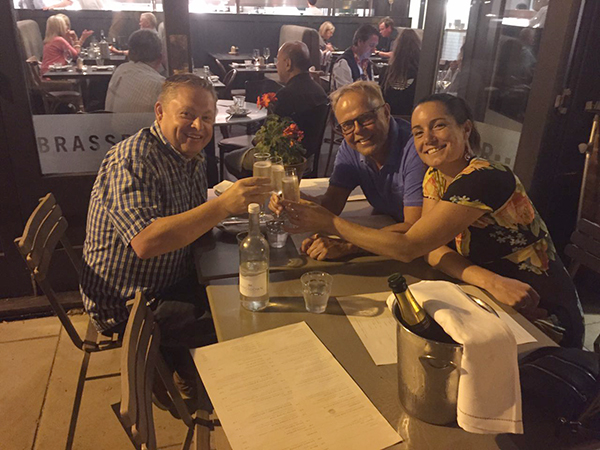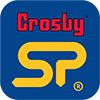The day an all-singing, all-dancing product launches is not as momentous as one might think, says Mr. Loadlink.
I enjoyed John Molidor’s guest blog last month. His comments about people in particular really resonated with me. John, the general manager of our North American operation, shares his passion for people with most of us at Straightpoint. We enjoy the vibrancy of our workplaces and those of us on the front line like nothing more than getting out onsite and networking with industry professionals. As John put it, “I feel at my most effective when I’m out of the office or dealing with people,” and he’s not the only one.
However, the other ‘P’—Product—is pretty important too. Look at our mission statement. At its heart is the mantra, ‘Making the lifting industry a safer place’. Underneath that it says, ‘We accomplish this through world-class customer service and innovative, forward-thinking products’. Product and People go hand in glove. Take other buzzwords from our vision and values… Repair, Calibration, Accuracy… it takes that combination to deliver on many of our promises to industry. Where would one be without the other?
This blog isn’t intended to be cryptic, like the chicken and the egg. My point is that our product range is the embodiment of our people’s expertise and engineering brilliance. It’s our products that actually keep people safe and it’s those products upon which we will base our growth plans. With that in mind, I want to take a moment to share with you what goes into development of our solutions and why there are many more important moments than the day they get put to market.
We get carried away with product launches. The word ‘launch’ is misleading in itself because people think of rockets. There’s great anticipation and excitement as the countdown reaches zero, then the spaceship soars up into the sky and off on a voyage of discovery. In other industries lights, curtains, platforms, music and champagne are used to create a similar sense of suspense and euphoria. I’m all for marking achievement and enjoying success, but it’s the sense of importance and completion in these occasions that unsettles me. I mean we’ve still got some guys up there soaring towards space with a scorching mass of fire under them. Why are we high-fiving each other?
Room for improvement
A product is conceptualised, researched, designed, tested, improved, scrapped, redesigned, tested, improved, improved, marketed, sold and improved. Sometimes the stages of evolution are even greater in number. Somewhere along the line it will be launched, which, granted, is worth noting on the calendar, but is that really the part we should enjoy most or the point where we can rope off the workshop and nail a plaque to the wall so we can point it out to visitors in years to come and say, “That’s where we built the Gongoozler 2000”? I don’t think so.
It’s tempting to use as an example our new Proof Test plus software (or SW-PTP), which adds speed, accuracy and breadth to data recording and certification related to non-destructive load verification or proof load testing. But I’m not going to talk specifically about that as this is a non-commercial blog, so let’s generalise and apply this guidance to New Product A. It doesn’t matter what that product does—it could measure force, control at great distance, lift at great speed or offer incredible, record-breaking capacity.
Think of the big days for New Product A before the launch. A customer might have said they wished a product could do X, Y or Z; an engineer may have burst into the boardroom yelling, “Look what I’ve found”; a brainstorming session could have gone particularly well; or a new technology might have been developed making possible what was once unfeasible. I’m not suggesting we all keep dozens of bottles of champagne on ice in the workplace to mark each one, but you take my point.
Let’s skip forward a bit. When New Product A has reached a point where it can be use in applications, it’s important not to go too big too early. Develop a trusted network of partners, maybe the ones whose comments prompted a particular research and development programme. Give them the product to experiment with. This can be done at various stages of the product’s life. The day when their feedback leads an engineer to making a significant improvement to New Product A is bigger than the launch, right? The marketing team is so excited they want to rename it the Fizz Banger!
Mission control
Even after the product goes to market in a wider sense—and this is the crux of my article—keep getting feedback from those using it. In the command centre, keep the headphones on. Once a month (or often) get the emails, photos and telephone messages together and get the team around a whiteboard. Write all the feedback down with New Product A in the centre of the page. Discuss each one and decide if it can be addressed.
The engineering team might say a few improvements are easy to make. Some feedback might be very industry specific, in which case it’s worth considering if there’s a market for a special version or if custom units are more suited. Other suggestions will not be feasible. In every case, explain to the provider of the information if you can incorporate their observations or not. If the latter, outline the reasons why and work with them to apply a different product or solution for which New Product A is not suited.
Pretty soon (I’m tempted to use SW-PTP as an example again but I promised not to!) a New Product A Version Two might be created—measuring greater force, controlling at far great distance, lifting at the same great speed but with better operator assistance, or setting a new capacity record. Ok, the improvements are likely to be subtler than that but it’s amazing how inspiring feedback from a marketplace can be. More exciting than the launch, I say.
We’re already planning new products (B and C, if you like) here at Straightpoint, which were the subject of a two-day session earlier this month. Roshan Divakaran, design engineer and Sarath Chandran, project engineer joined myself and some external representatives to experiment with computer-aided design (CAD) and discuss a number of exciting innovations. I’m looking forward to all the key moments through their development and, while I’ll be there when we press the launch button, I’m not sure it will be my favourite day of them all.
Data driven decision-making
Regular readers of this blog will know what a prolific planner I am. One such stratagem is to mark 2017 as a year of data driven decision-making. To that end, we have invested in new customer relationship management (CRM) software that will help us even more efficiently manage quotes, relationships, contracts, projects, marketing and more. Our old system was server-based and we wanted to go to a cloud-based system.
Planning and measurement go together like people and products. The new software will give us access to a myriad of metrics so we can examine each department, its organisms and the people within them. It sounds creepy to say we want to have eyes and ears everywhere, but we want to implement a system whereby high performance can be acknowledged and serve as a guide where we may have capacity for improvement. Of course, it will also help us analyse products and their success in different sectors and geographies.
Similarly, we are now using an enhanced system for global stock management. With product (there it is again) in the UK; Camarillo, California; and Houston, Texas, it’s important to keep track of everything and ensure the inventory reflects demand. If, say, John receives an order for 50 load cells, the system will find the necessary components, calculate a build time and give us information to pass onto the customer about delivery. I’d urge other businesses to look at their inventory management, particularly if they work across multiple time zones, as an order can be advanced regardless of the availability of someone in another facility.
Wipe out

My son, Isaac, and I at the top of Willis Tower—still commonly referred to as Sears Tower—in Chicago.
I’ve enjoyed a good measure of downtime since my last blog, which included a two-week break with my son, Isaac. We visited Chicago and California, where we joined Myron Jones, operations manager and Scott Abernethy, technical specialist on the waves with our surfboards. Surfers use the term ‘aggro’ to describe aggressive attitude in the water but the whole experience was more akin to the generic version of the word. Honestly, it was one of the hardest, most physical sports I have ever tried, even if it was an incredible experience.
- The start of a bleak day on the golf course, but all for a good cause.
- Gary Mullins, of Action Coach, celebrates his charity golf day success.
I also swung a golf club or two, badly but in aid of a good cause, at an event to raise money for the Ickle Pickle Partnership, which turns gifts and donations into specialised equipment such as incubators and ventilators to help neonatal units provide care for sick babies. It’s a charity close to my heart because my daughter, who is 21 years old now, was born prematurely and I understand the heartbreak that can be caused when newborn babies are poorly. Gary Mullins, of Action Coach, a leading business coaching company, was among the winners in a secret four-ball format.

It’s always a pleasure to catch up with the guys at Dutch distributor Van Gool.
There’s just enough time to express my gratitude to distributors Rigmarine and Van Gool who participated in networking and training sessions since my last blog. And thanks once more to John for stepping in to cover me last month.
Follow us on Twitter at @LoadCell and use the hashtags #loadcell and #belowthehook to engage.
Mr. Loadlink


